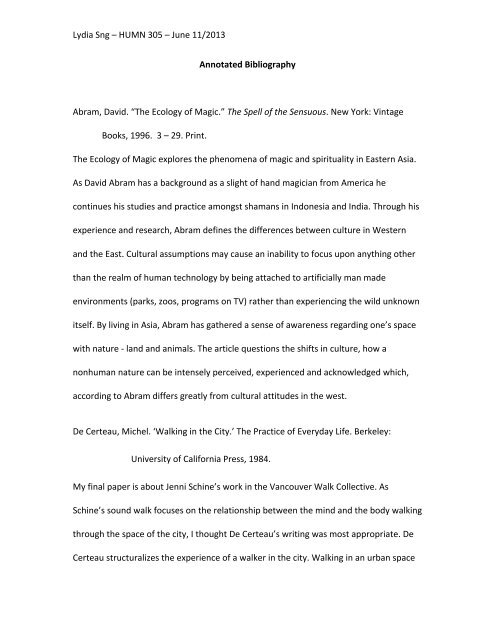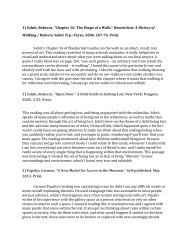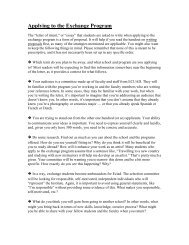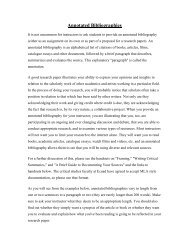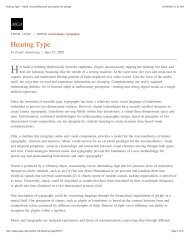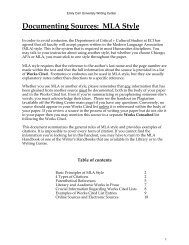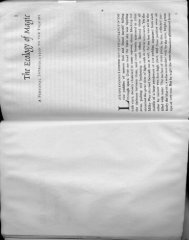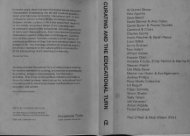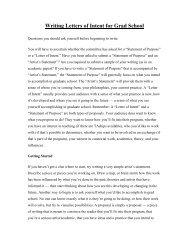Create successful ePaper yourself
Turn your PDF publications into a flip-book with our unique Google optimized e-Paper software.
Lydia Sng – HUMN 305 – June 11/2013<br />
Annotated Bibliography<br />
Abram, David. “The Ecology of Magic.” The Spell of the Sensuous. New York: Vintage<br />
Books, 1996. 3 – 29. Print.<br />
The Ecology of Magic explores the phenomena of magic and spirituality in Eastern Asia.<br />
As David Abram has a background as a slight of hand magician from America he<br />
continues his studies and practice amongst shamans in Indonesia and India. Through his<br />
experience and research, Abram defines the differences between culture in Western<br />
and the East. Cultural assumptions may cause an inability to focus upon anything other<br />
than the realm of human technology by being attached to artificially man made<br />
environments (parks, zoos, programs on TV) rather than experiencing the wild unknown<br />
itself. By living in Asia, Abram has gathered a sense of awareness regarding one’s space<br />
with nature -‐ land and animals. The article questions the shifts in culture, how a<br />
nonhuman nature can be intensely perceived, experienced and acknowledged which,<br />
according to Abram differs greatly from cultural attitudes in the west.<br />
De Certeau, Michel. ‘Walking in the City.’ The Practice of Everyday Life. Berkeley:<br />
University of California Press, 1984.<br />
My final paper is about Jenni Schine’s work in the Vancouver Walk Collective. As<br />
Schine’s sound walk focuses on the relationship between the mind and the body walking<br />
through the space of the city, I thought De Certeau’s writing was most appropriate. De<br />
Certeau structuralizes the experience of a walker in the city. Walking in an urban space
Lydia Sng – HUMN 305 – June 11/2013<br />
can provide one with a calling to explore the unknown, their body guiding itself through<br />
the environment of a city by absorbing the sights and sound. De Certeau characterizes<br />
how our memory distinctly links a person to a place and a time, an aspect I am<br />
approaching in my final paper.<br />
Morgan, Stuart. “Suite Venitienne.” Frieze 3 (1992): n. pag. Web.<br />
The peculiar and controversial work of Sophie Calle’s Suite Venitienne is observed in this<br />
article from Frieze 3. Suite Venitienne follows Calle as she tracks a man through Paris<br />
who she met previously before. She dedicates herself to photographing him and<br />
shadows the man who she calls Henri B from place to place. Through this practice Calle<br />
finds herself having conflicting thoughts, as a person and an artist. She is not amorous<br />
towards Henri B. but treats him as a subject as apart of her practice. Stuart Morgan<br />
analyzes Suite Venitienne and the psychological, making comparison towards Vito<br />
Acconi’s Following piece that has similarities to Calle by putting oneself as risk or<br />
discovery.<br />
Papalia, Carmen. “A New Model for Access in the Museum.” Self-‐published. May 2013.<br />
Print.<br />
Carmen Papalia’s writing is on exactly what the title states, proposing a new model<br />
towards one’s experience in a museum. Papalia discusses the lack of accessibility and<br />
the sense of detachment when it comes to viewing work, as there are many restrictions<br />
one must abide to under the social setting of an art gallery. Papalia writes from personal
Lydia Sng – HUMN 305 – June 11/2013<br />
experience on their own issues with accessibility (losing their vision) and how they<br />
became to use it as a focus by public perceptions around disability through their works.<br />
Leading a “blind” walk of 50 people holding hands with their eyes closed, Papalia<br />
allowed participants to recognize the limitations created by relying on sight. The article<br />
brings awareness that a gallery space is not only an experience of sight and artwork<br />
itself but also of the other senses such as “comforting feeling of a cozy gallery, the smell<br />
of an ancient collection and the chatter of excited visitors.”<br />
Plumwood, Val. “Surviving a Crocodile Attack.” Utne Reader. July-‐August 2000. Online.<br />
Val Plumwood writes about surviving a terrifying encounter with a saltwater crocodile<br />
while canoeing in Australia’s Kakadu National Park. Plumwood was plunged into water<br />
held by the suffocating grasp of a crocodile’s legs and being able to escape through her<br />
own will and strength. The near death experience has provoked Plumwood to re-‐<br />
evaluate her self, her connections to others and the natural world. Gender roles and<br />
sexuality are taken into account, the notion that media has made the wild no place for<br />
women. Through Plumwood’s experience she discusses Australia’s (and Western<br />
society) media stereotype on women being seemingly helpless against the wilderness<br />
and being rescued by a heroic masculine figure which proves to not be the case as she<br />
was capable of surviving using her own power as a woman.<br />
Roelstraete, Dieter. “A Line Made By Walking.” Richard Long: A Line Made by Walking.<br />
London: Afterall, 2010. 1-‐16. Print.
Lydia Sng – HUMN 305 – June 11/2013<br />
Dieter Roelstraete introduces the reader to conceptual walk/land artist Richard Long<br />
and his work, A Line Made by Walking. Long walked back and forth in a straight line in<br />
the countryside which left a track then photographed it. This work was a jump-‐start for<br />
Long’s artistic career. The writing touches upon the beginning of his walk origins and his<br />
education in the fine arts. In regards to the process of Long’s A Line Made by Walking,<br />
Roelstraete makes references to philosopher, Jean-‐Jacques Rosseau who states that a<br />
full meditative state is made through walking and ceases once one stops their walk.<br />
Rebecca Solnit is also mentioned, further discussing the properties of walking as a state<br />
aligning the body, mind and world.<br />
Schine, Jennifer. "Sensory Studies." MOVEMENT, MEMORY & THE SENSES IN<br />
SOUNDSCAPE STUDIES –. SENSORY STUDIES, 23 June 2010. Web. 04 June 2013.<br />
.<br />
As my final paper is based on Schine’s sound walk of the Vancouver Walk Collective, I<br />
thought it would be appropriate to include writing by her. Schine talks about the<br />
practice of sound walking itself. Schine states how a sound walk is produced by actively<br />
listening to the sounds of one’s environment while passing through the space. Schine<br />
talks about the main focus of her writing is to question the relationship between the<br />
body and mind, through sound we can evoke the physical and emotional to connect<br />
with our surroundings. She cites the studies of composers and anthropologies that<br />
further elaborate on our relationship through movement with our social environment.<br />
This reading is a primary source that will be contributing to my paper.
Lydia Sng – HUMN 305 – June 11/2013<br />
Solnit, Rebecca. “Open Door.” A Field Guide to Getting Lost. New York: Penguin, 2005. 3-‐<br />
25. Print.<br />
Solnit speaks upon experiences of becoming lost in the everyday. The origin of the word<br />
lost is discussed as well as the idea of being immersed into the unknown to become lost.<br />
The role of the artist is mentioned to explore the unknown, to be lost and broaden work<br />
through it. The mental and emotional state of being lost is mentioned by personal<br />
accounts. Solnit describes being lost to have two meanings. Having the desire to be lost<br />
or having the unfamiliar appear creates moments of discovery and newfound self-‐<br />
identity. While losing things is about the familiar (physical objects, relationships, etc.)<br />
disappearing. Solnit directs the reader towards looking to the unknown and becoming<br />
lost in experience.<br />
Solnit, Rebecca. “Paris or Botanizing on the Asphalt.” Wanderlust. New York: Penguin,<br />
2000. 196-‐213. Print.<br />
Rebecca Solnit writes on Walter Benjamin’s experience and fascination with the Parisian<br />
city lifestyle in the early 1900s. Paris is a city where one can lose themselves within the<br />
city streets. The idea of the flaneur is introduced as one (a male figure) who takes in the<br />
city and observes their surroundings through the experience of strolling. The flaneur is<br />
an aloof, visual consumer who resists industrialization and the consumption of goods.<br />
The aspect of Haussmannization is discussed in this reading, identifying the reform in
Lydia Sng – HUMN 305 – June 11/2013<br />
Paris that took place during the late 1800s to 1900s. The urban planning caused social,<br />
economical and architectural change throughout the city.<br />
Sisson, Mark. ‘The Power of Daydreaming: Why You Should Let your Mind Wander.’<br />
Mark’s Daily Apple: Primal Living in the Modern World. 25 July, 2012. Web. 06<br />
June. 2013.<br />
Sisson’s article on daydreaming speaks upon the human cognition and the affects it<br />
undergoes while in the act of walking. My final paper focuses on Jenni Schine’s sound<br />
walks that connect our mind, body and environment; Sisson mentions this phenomenon<br />
as well although this article does not regard sound but rather it focuses the process of<br />
our mind and memories. The reflective state of being in a daydreaming can be acquired<br />
through walking. A reverie opens up the mind and imagination; it is critical as reflection<br />
contributes to the development of the mind and one’s emotional well-‐being.


